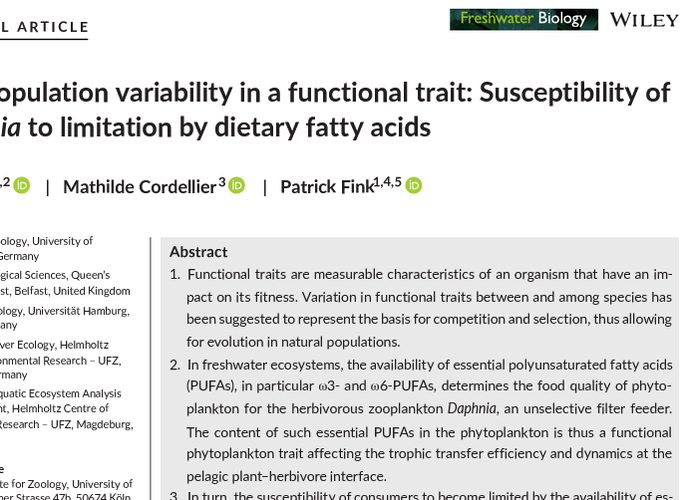Intrapopulation variability in a functional trait - Susceptibility of Daphnia to limitation by dietary fatty acids
Abstract
Functional traits are measurable characteristics of an organism that have an impact on its fitness. Variation in functional traits between and among species has been suggested to represent the basis for competition and selection, thus allowing for evolution in natural populations. In freshwater ecosystems, the availability of essential polyunsaturated fatty acids (PUFAs), in particular omega3- and omega6-PUFAs, determines the food quality of phytoplankton for the herbivorous zooplankton Daphnia, an unselective filter feeder. The content of such essential PUFAs in the phytoplankton is thus a functional phytoplankton trait affecting the trophic transfer efficiency and dynamics at the pelagic plant-herbivore interface. In turn, the susceptibility of consumers to become limited by the availability of essential PUFAs is a fitness-determining trait of Daphnia genotypes, and variability of this herbivore trait may thus affect the daphnids’ intrapopulation competition. To estimate the intrapopulation variation in susceptibility, we isolated clonal lines of Daphnia longispina from a natural population and compared the strength of their limitation by dietary PUFA availability via standardised laboratory growth assays. We used a liposome supplementation technique to enrich a PUFA-poor green alga with essential omega3- and omega6-PUFAs and determined juvenile somatic growth rate of different D. longispina genotypes as a fitness proxy. As expected, D. longispina genotypes that coexisted in a natural population differed markedly in their specific patterns of susceptibility to dietary PUFA availability. On average, the D. longispina population was more strongly susceptible to limitations in the availability of the omega6-PUFA arachidonic acid (20:4 n-6) than to limitations in the availability of omega3-PUFAs alpha-linolenic acid (18:3 n-3) and eicosapentaenoic acid (20:5 n-3). The ability to cope with PUFA limitation is thus a crucial trait that can probably affect intraspecific competition and Daphnia population structure. Therefore, we suggest that such intrapopulation variation in susceptibility to absence of dietary PUFAs might be one of the driving forces of natural selection and local adaptation among freshwater zooplankton.
